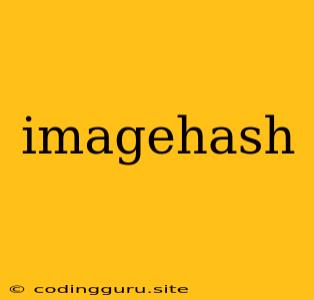What is ImageHash?
ImageHash is a powerful technique used to generate a unique, compact representation of an image. It's like a digital fingerprint that allows you to quickly compare images for similarity or detect subtle differences, even when dealing with large datasets.
Imagine you have a massive collection of images. You want to know if a new image is a duplicate or a variation of one you already have. Manually comparing each image would be tedious and time-consuming. This is where image hashing comes in!
How does ImageHash work?
The concept is simple: ImageHash algorithms analyze an image and create a short, unique hash value. This hash value is a numerical representation that captures the essence of the image's content.
Here's a breakdown of how it works:
- Preprocessing: The image is typically resized and converted to grayscale to simplify the analysis.
- Feature Extraction: Algorithms like Perceptual Hashing (pHash) or Average Hashing (aHash) analyze the image's features. They might look at the distribution of pixels, edges, or other visual elements.
- Hash Generation: Based on the extracted features, a unique hash value is generated. This hash value is usually a short string of bits or a number.
What are the benefits of using ImageHash?
ImageHash offers several advantages over traditional image comparison methods:
- Speed: Comparing hash values is incredibly fast, making it ideal for large-scale image analysis.
- Efficiency: Hash values are much smaller than images themselves, saving storage space and bandwidth.
- Robustness: ImageHash algorithms are designed to be robust against minor changes, such as resizing, cropping, or compression.
- Versatility: ImageHash can be used in various applications, from duplicate detection to image search and content moderation.
How can I use ImageHash?
There are various open-source libraries and tools available that implement different ImageHash algorithms. You can find them for various programming languages, including Python, JavaScript, and Java.
Here are some examples:
Python:
- imagehash: This library provides several hashing algorithms like aHash, dHash, and pHash.
- PIL (Pillow): This library has built-in functionality for image processing and can be used to calculate ImageHash values.
JavaScript:
- js-imagehash: A JavaScript library offering implementations of different ImageHash algorithms.
- image-hash-lib: Another popular JavaScript library for calculating ImageHash values.
What are the different types of ImageHash algorithms?
There are several ImageHash algorithms, each with its strengths and weaknesses. Some popular ones include:
- Average Hash (aHash): This algorithm calculates the average pixel value and compares it to a threshold. It's relatively simple and fast but sensitive to noise.
- Perceptual Hash (pHash): This algorithm uses Discrete Cosine Transform (DCT) to create a perceptual hash that is robust to minor changes in the image.
- Difference Hash (dHash): This algorithm compares adjacent pixels and calculates a hash based on the differences. It's good for detecting subtle differences but can be sensitive to changes in contrast.
- Wavelet Hash (wHash): This algorithm uses wavelets to analyze the image's frequency content and generate a robust hash.
What are some real-world applications of ImageHash?
ImageHash is used in various practical applications, including:
- Duplicate Image Detection: Identify and remove duplicate images from a large dataset to save storage space.
- Image Search: Use ImageHash to find visually similar images in a database.
- Content Moderation: Detect and filter inappropriate content, such as copyrighted images or offensive material.
- Image Recognition: ImageHash can be used as a feature for image recognition systems.
- Video Analysis: Detect frame-by-frame similarities in video sequences for video analysis.
Conclusion
ImageHash is a powerful tool that offers efficient and reliable image comparison capabilities. It has numerous applications in various fields, including image search, content moderation, and video analysis. By leveraging ImageHash algorithms, developers can overcome the challenges of handling large datasets of images and efficiently identify similar or duplicate content.
